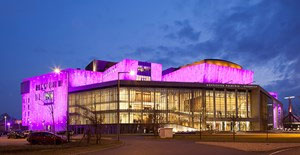
The Palace of Arts
The Palace of Arts - Budapest in Hungary (locally named Művészetek Palotája, abbreviated Müpa) is one of the most prestigious concert halls in Central and Eastern Europe.
Its previous colour-changing lighting system, installed a decade ago, had become outdated and did not provide the deep, highly saturated colouration desired by the architect.
Tamás Fazekas, SGM’s local distributor from Zaj System House Trading, explains: “As this is a stand-alone building on the banks of the Danube, which is bordered by one of the busiest bridges in the city, all of the façades are of equal importance and the lighting system must concentrate on each of them without any exclusion.”
Different lighting manufacturers participated in the tender bid and thus a shootout was held on two chilly evenings where the products were put through their paces. “The dominance of the SGM P-5 was unquestionable from the beginning,” says Tamás Fazekas. “No other product had such lighting power, which was very important because of the high level of surrounding street lighting and light pollution coming from different sources.”
90 P-5 wash lights were used for the extensive façade illumination. 48 of these were custom-made in silver colour to be placed on 5- and 8-meter high columns (2 or 4 units per column) to resemble the former fixtures, although the smaller shape and size of the P-5s creates a clear benefit. The remaining SGM wash lights are placed on terraces, roofs and stands in the garden - three pieces are even mounted at 18-meter height in the atrium, which were installed by industrial ‘alpinists’ as no one else could achieve this height.
The objective was achieved by introducing the P-5 to Müpa; a LED technology based, small sized, elegant, custom colour finished, low power consumption – but very high power output fixture, which offers different projection angles and fulfils the architect’s original dream to turn the complete building into any deep and saturated, or light pastel colour desired.
“As the old system could not produce sufficient light power in deep, saturated colours, in recent years the building has mostly been illuminated in white or very light colour, e.g. yellow. The new possibilities provided by the enormous power of the P-5’s began the fantasy and creativity of the architects and operators,” Tamás Fazekas explains.



